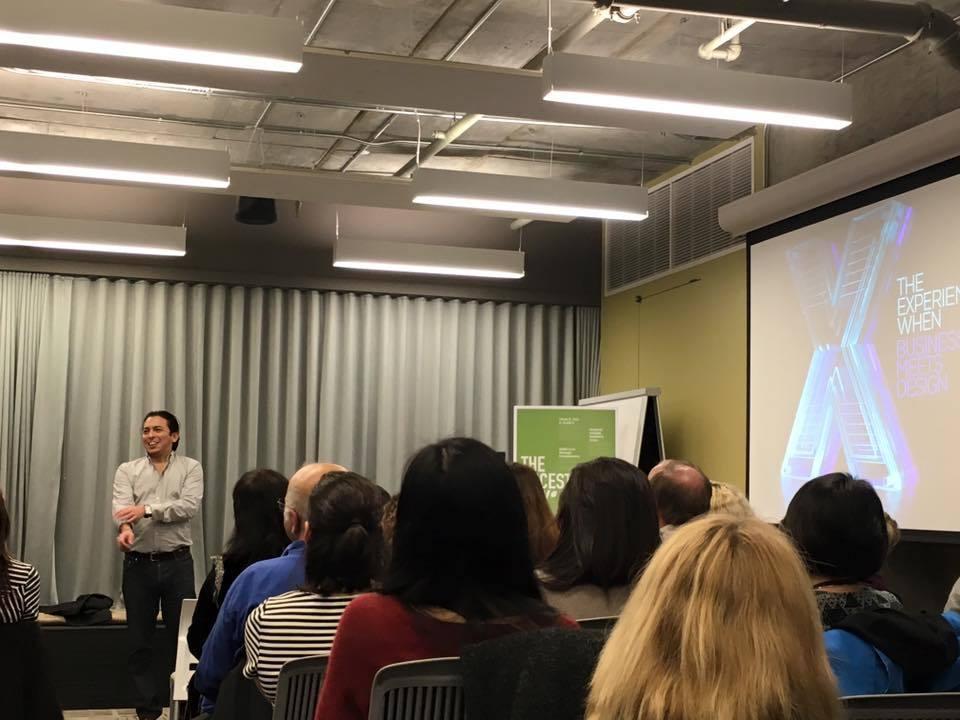
I was very excited when I heard Near Me was sponsoring Brian Solis’ book tour here in San Francisco. One of the first articles I curated was written by him, which encouraged me to think about the impact technology has on our lives and how we interact with each other. In person, Solis delivers the goods in an even more engaging and persuasive fashion. An eloquent and humorous speaker, he wowed the audience with his reflections on designing user experiences in a digital and real-time world.
Creating an experience in a digital world
As I was about to type up this article, a message popped up on my screen saying my browser needed updating. No, I didn’t freak out and go into Internet withdrawal because I usually begin writing longhand. So here I am, writing about experiences with a pen. I enjoy the process of creating sleek strokes on the thin paper in my black notebook, feeling the pen between my fingers as the words seem to channel through me. Likewise was my experience picking up Solis’ book. It is quite large but sleek, the cover made out of black matte paper with an aqua blue and fuschia X that pops out in almost three-dimensional illusion X: THE EXPERIENCE WHEN BUSINESS MEETS DESIGN.
The first time I held it I noticed how big it was, reminding me of my college years leaving a classroom with my reading assignment in hand. Yet inside, there was nothing academic about it and I was transported by its rich layout which, ironically, reminds me of being online.
Why publish a book when everyone accesses information online?
As he pulled out an image on the screen above us, Solis joked that you know you’re on the cusp of innovation when you’re using powerpoint. It was a picture of a crowd taking pictures with their smartphones of some event. But not everyone was capturing the moment instead of living it -- an older woman stood on the edge, wide-eyed and expressive. Of course, I was taking a picture as he said this.
We still experience real life, but feel a pull to share with our Twitter followers and Facebook friends. There isn’t anything wrong with that, but maybe we can be more aware of what we are experiencing. As I leaf through the aesthetically designed book, no messages pop up alerting me that I have an Instagram follower, or remind me of my meeting tomorrow -- maybe that’s the point.
A magazine is an iPad that doesn’t work
What happens when you give a one year old an iPad? Solis used the example of a father who did just that, then a year later replaced the screen with a magazine. The result? The little girl became frustrated and tossed the lifeless collection of paper to the side. Today, children are conditioned to use technology first, then traditional forms of media like magazines or books later. How can storytelling help us re-engage people? By having empathy for customers -- that is walking in their shoes -- brands can begin to understand how to design more intuitive products that engage people at every step of the buying process.
How the art of storytelling connects brands to consumers
Filmmakers use storyboards to map out scenes in a linear sequence to help the director plan his onscreen action. Without a clear view of what your message is, and how you’re getting it across, it’s impossible to communicate effectively. The same applies to conveying your brand’s message. Airbnb used storyboards to portray the experiences of different customers, allowing them and their customers to see the journey. This is a great way to understand who is using your product, and how to connect with them to design seamless user experiences. Here are questions that came into my mind after hearing Brian talk and leafing through his book:
- Who are your customers?
- What kind of online/real-life experience are they yearning for?
- How do you reach them and win them over -- not for a one time transaction, but ongoingly?
- Do you love your customers?
These questions can be applied to peer-to-peer marketplaces by pushing entrepreneurs to think about engaging their customers and creating an intuitive user experience. And that’s the difference between companies that engage and those who will fall on the sidelines: they don’t know how to connect with their customers beyond the initial sale.
I felt a connection to Solis from that very first article I read by him, to him signing a copy of my book and writing a personal message inside. He was someone I looked up to, but then became real. I hope to do the same with my writing and create experiences that people want to share or simply take in.
“The secret of change is to focus your energy, not on fighting the old, but on building the new.”
--Socrates



